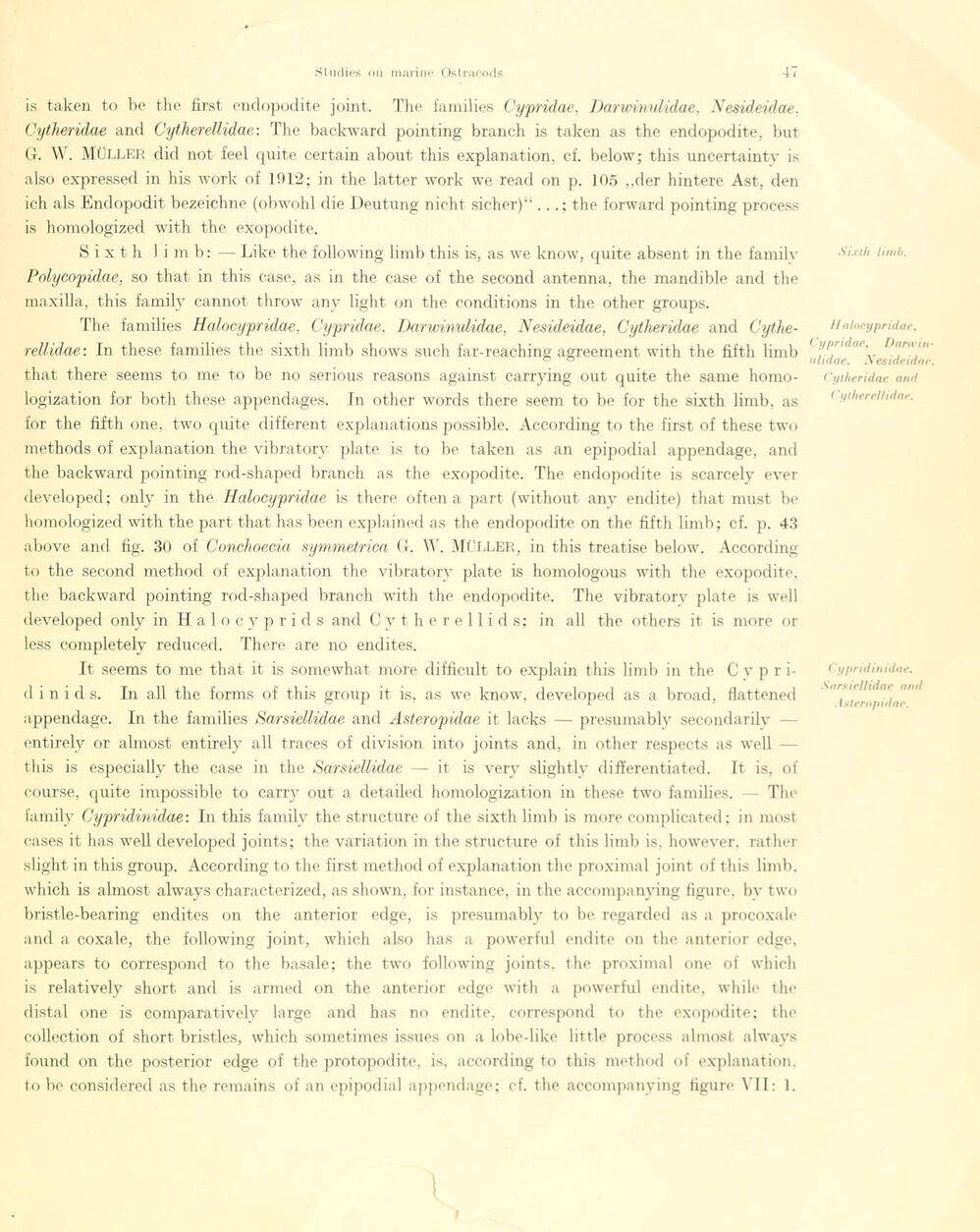
Full resolution (JPEG) - On this page / på denna sida - Sidor ...

<< prev. page << föreg. sida << >> nästa sida >> next page >>
Below is the raw OCR text
from the above scanned image.
Do you see an error? Proofread the page now!
Här nedan syns maskintolkade texten från faksimilbilden ovan.
Ser du något fel? Korrekturläs sidan nu!
This page has never been proofread. / Denna sida har aldrig korrekturlästs.
is taken to be the first endopodite joint. The families C y pr idae, Darmnulidae, Nesideidae.
Cytheridae and CytheréUidae: The backward pointing brauch is taken as the endopodite, but
G. W. Müller did not feel quite certain about this explanation, ci below; this uncertainty is
also expressed in his work of 1912; in the latter work we read on p. 105 ,,der hintere Ast, den
ich als Endopodit bezeichne (obwohl die Deutung nicht sicher)“ ..the forward pointing process
is homologized with the exopodite.
S i X t h 1 i m b: — Like the following limb this is, as we know, quite absent in the family
Polycopidae, so that in this case, as in the case of the second antenna, the mandible and the
maxilla, this family cannot throw any light on the conditions in the other groups.
The families Halocypridae, Cypridae, Darmnulidae, Nesideidae, Cytheridae and
Cythe-rellidae: In these families the sixth limb shows such far-reaching agreement with the fiftli limb
that there seems to me to be no serious reasons against carrying out quite the same
homo-logization for both these appendages. In other words there seem to be for the sixth limb, as
for the fifth one, two quite different explanations possible. According to the first of these two
methods of explanation the vibratory plate is to be tåken as an epipodial appendage, and
the backward pointing rod-shaped branch as the exopodite. The endopodite is scarcely ever
developed; only in the Halocypridae is there often a part (without any endite) that must be
homologized with the part that has been explained as the endopodite on the fifth limb; cf. p. 43
above and fig. 30 of Conchoecia symmetrica G. W. MÜLLER, in this treatise below. According
to the second method of explanation the vibratory plate is homologous with the exopodite,
the backward pointing rod-shaped branch with the endopodite. The vibratory plate is well
developed only in Halocyprids and Cytherellids; in all the others it is more or
less completely reduced. There are no endites.
It seems to me that it is somewhat more difficult to explain this limb in the C y p r
i-d i n i d s. In all the forms of this group it is, as we know, developed as a broad, flattened
appendage. In the families Sarsiellidae and Asteropidae it lacks — presumablv secondarily
entirely or almost entirely all traces of division into joints and, in other respects as well
-this is especially the case in the Sarsiellidae — it is very slightly differentiated. It is, of
course, quite impossible to carry out a detailed homologization in these two families. — The
family Cypridinidae: In this family the structure of the sixth limb is more complicated; in most
cases it has well developed joints; the variation in the structure of this limb is, however. rather
slight in this group. According to the first method of explanation the proximal joint of this limb.
which is almost always characterized, as shown, for instance, in the accompanying figure, by two
bristle-bearing endites on the anterior edge, is presumablv to be regarded as a procoxale
and a coxale, the following joint, which also has a powerful endite on the anterior edge,
appears to correspond to the basale; the two following joints, the proximal one of which
is relatively short and is armed on the anterior edge with a powerful endite, while the
distal one is comparativelv large and has no endite. correspond to the exopodite; the
collection of short bristles, which sometimes issues on a lobe-like lit tle process almost always
found on the posterior edge of the protopodite, is, according to this method of explanation,
to be considered as the remains of an epipodial appendage; cf. the accompanying figure \ II: 1.
Si.i’lh liinli.
// alocypridae,
Cypridae.
Danvin-nlidae, Nesideidae.
Cytheridae and
( ’ythereUidae.
Cypridinidae.
Sarsiellidae and
Asteropidar.
<< prev. page << föreg. sida << >> nästa sida >> next page >>